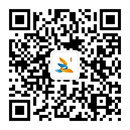康复物理治疗
Physical Therapy
一、专业简介
广州医科大学于2005年开办康复治疗学专业,2016年将康复治疗学专业分为物理治疗方向(physiotherapy, PT)和作业治疗方向培养,2020年获教育部审批开办康复物理治疗专业。康复物理治疗是在物理治疗师指导及监督下,进行问诊、检查、评估、分析诊断、判断预后、干预 / 治疗和复诊的一系列过程,要求物理治疗师拥有较强的临床实践能力、逻辑推理思维等综合性技能的专业。物理治疗师通过运用现代三大物理治疗方法,即物理因子疗法(冷法、热疗、FES、NMES、TENS、超声波、水疗等)、手法治疗(关节松动术、牵伸、神经松动术、PNF、肌筋膜松解等)和运动疗法治疗(神经发育疗法、运动再学习、肌力训练、有氧训练等),和中医传统康复技术(针灸、推拿、运动功法)相结合,从而治疗肌肉骨骼疾病、心肺疾病、神经系统疾病等引起的功能障碍,使患者其尽可能早日回归家庭、回归社会,提高患者的生活质量。
二、培养目标
培养适应我国社会主义现代化建设和康复物理治疗事业发展需要,德、智、体、美、劳全面发展,具有扎实的基本知识、基础理论和基本技能,具有人文情怀、国际视野、创新精神和实践能力的高素质物理治疗师人才。毕业生能够胜任康复物理治疗相关的临床、教学及科研等相关工作。
三、标准学制与时间分配
1. 标准学制:四年。
2. 专业时间分配表(按周计算)。
项目 学期 | 教学 | 集中实践 | 考试 | 假期 | 合计 |
一 | 15 | 2 | 1 | 5 | 52 |
二 | 18 | 2 | 1 | 7 | |
三 | 18 | 1 | 1 | 5 | 52 |
四 | 18 | 2 | 1 | 7 | |
五 | 18 | 1 | 6 | 52 | |
六 | 13 | 52 | 1 | 13 | |
七 | 52 | ||||
八 | |||||
合计 | 100 | 59 | 6 | 43 | 208 |
四、师资队伍
本专业具有共教师165人,其中专任教师148人,兼任教师17人, WPT认证教师18人;实习基地WPT认证教师共81人,均具有丰富的临床教学经验。罗庆禄教授为本专业负责人。
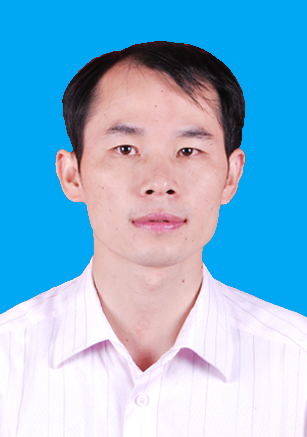
罗庆禄教授、博士研究生导师,副主任技师;四川大学华西临床医学院(原华西医科大学)康复医学与理疗学博士。广东省“南粤优秀教师”,广州医科大学“优秀教师”、教学督导组专家、大学学生创新创业指导老师,广州医科大学附属第五医院康复医学教研室主任、康复医学科副主任;中国康复医学会物理治疗专委会会员【通过中国康复治疗国际化教育物理治疗学专家委员会举办的《物理治疗师网络课程》考试(证书号:CPTP-240)】,中国康复医学会物理治疗专业委员会第一届物理治疗高校联盟常务委员,中国研究型医院学会骨科创新与转化专业委员会骨科康复委员会委员,广东省康复医学会老年康复分会常务理事,广东省医师协会运动医学分会委员会委员,广东省医学会物理医学与康复学分会第十一届委员会中西医结合学组成员
五、课程体系
1. 主干学科:基础学科、临床学科、物理治疗学。
2. 专业基础课程:人体解剖学、生理学、病理学、药理学、实验诊断学、临床诊断学、医学影像学、骨科学、内科学、神经病学、康复心理学、人体发育学、医学统计学、科研思路与方法等。
3. 核心课程:康复医学导论、物理治疗概述、功能解剖学、手法治疗学、物理因子疗法、成人神经疾病物理治疗学、小儿神经疾病物理治疗学、综合疾病物理治疗学、骨科疾病物理治疗学、心肺疾病物理治疗学、运动科学等。
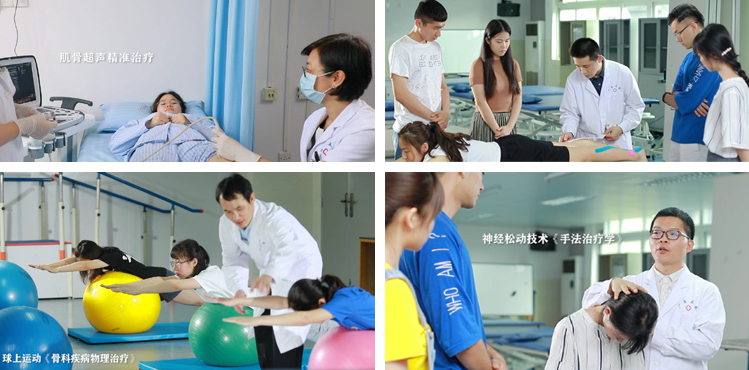
六、实践教学
康复物理治疗专业特点是以临床实践操作为主,学院重视实践教学平台建设,教学条件不断得到完善。康复物理治疗的实践教学是多级别和多样化的,共包含3个阶段,使学生的临床思维和实践能力逐步提高。
实践教学1(第2~5学期)是在课程中的实践课,学生可以去实验室、临床科室、康复中心进行与理论课对应的实践学习;
实践教学2(第2~5学期)包括集中见习、社会实践、志愿活动、海外见习交流等;
实践教学3为实习阶段(第6~8学期),包括肌肉骨骼疾病物理治疗实习、神经系统疾病物理治疗实习、心肺系统疾病物理治疗实习、小儿神经系统疾病物理治疗实习、社区/家居康复实习、康复科临床(病房、门诊)实习、言语及吞咽治疗实习、传统康复实习、作业治疗实习、毕业考核。
七、实践教学基地
在充分依托学校实验室的前提下,目前学院建设有两个专业实验室,总面积达 1200 平方米,实验教学中心全部向学生开放。
康复医学实验教学中心:建于2005年,广医康复医学实验教学中心为省级实验教学示范中心(简称中心),中心现有实训室占地面积 900 多平方米,仪器设备总值 1800 多万,其中 PT 专业实训室占地 640 平方米,包括神经系统疾病物理治疗实验室、心肺系统疾病物理治疗实验室、假肢与矫形器制作实验室、步态分析检测室和运动重建实验室、儿童康复实验室;
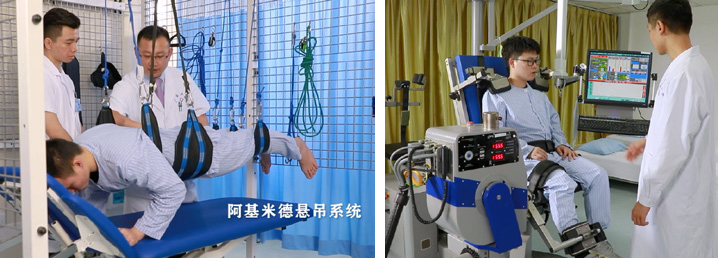
广医五院临床技能培训中心于 2018年3月成立,占地面积约 300 平方米,以高级模拟设备为基础,拥有多种现代化模拟教学仪器和设备。中心下设内科技能室、外科技能室、妇产科、儿科技能室、模拟 ICU 技能室,下设PT、OT、ST 技能培训室、康复评定室、PBL 课室、标准化病人俱乐部。主要承担物理治疗专业和作业治疗专业的外科学、儿科学、骨科学、内科学等临床基础学科的实践教学。
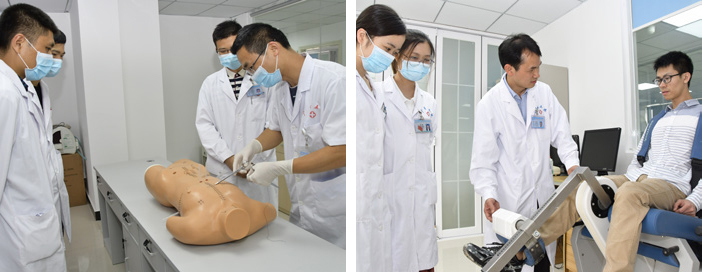
在实践教学3(实习)中,本专业依托大学各附属医院和全国各地具有符合 PT 国际认证要求带教师资的优质实习教学基地,构建了庞大的临床教学基地体系,临床教学资源丰富,能为学生见习和实习提供充足的实践操作机会,为康复物理治疗专业学生的实习提供坚实的保障。目前,承担 PT 专业临床实习教学的基地有 11 家,包括广州医科大学附属第五医院、广州医科大学附属第二医院、四川大学华西医院、同济大学附属养志康复医院、中山大学附属第一医院、中山大学附属第三医院、中山大学附属第六医院、广东省工伤康复医院、南方医科大学珠江医院、暨南大学附属第一医院、黄埔区泰景社区医院。
八、创新与个性发展平台
学校开设的创新与个性发展课程,学生可通过参加科学研究、创新创业、暑期课程、竞赛活动等获取创新学分。
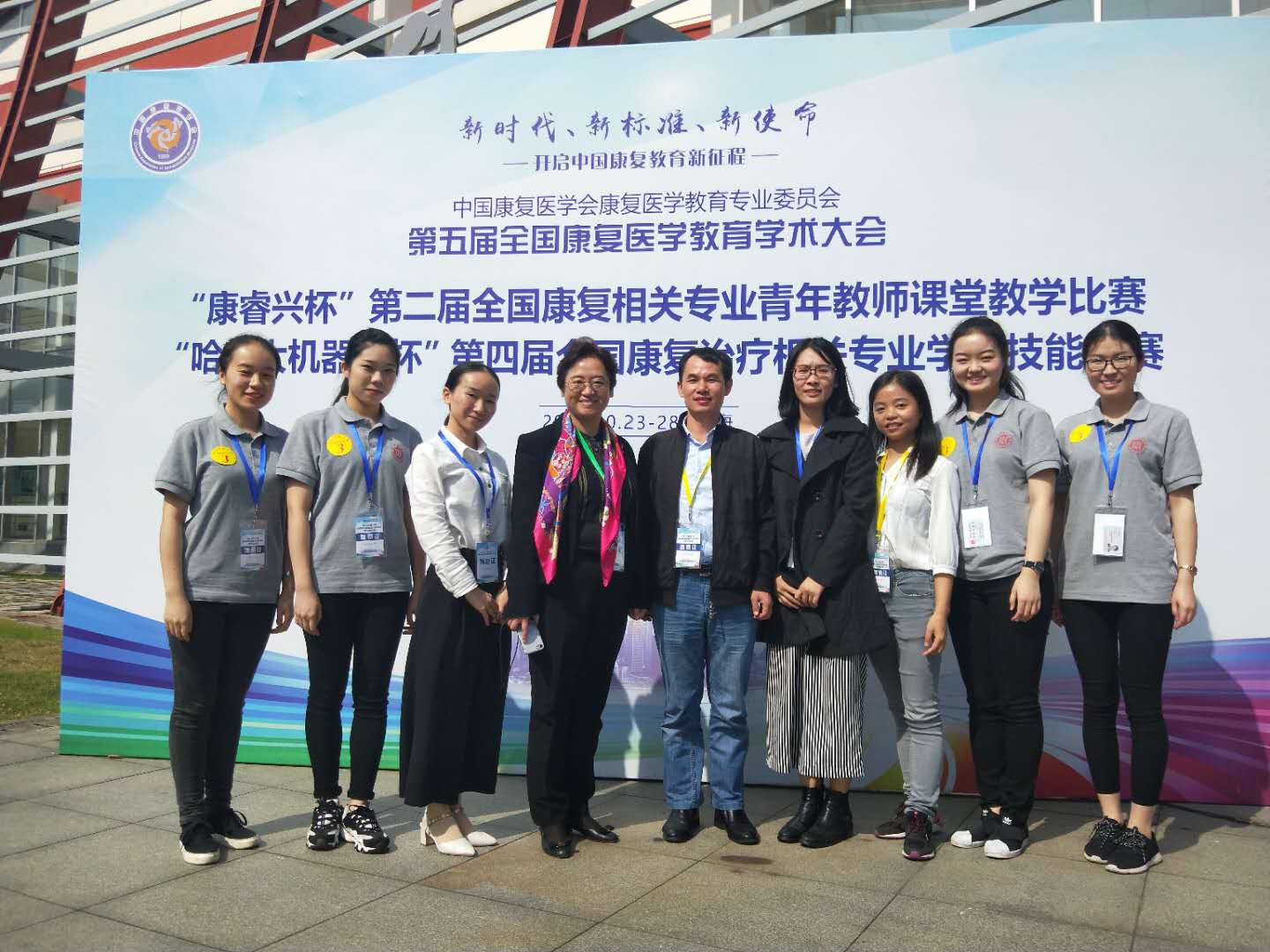
九、对外交流
康复物理治疗专业聘请多名香港理工大学、台湾中山医学大学的康复专家、教授担任课程主讲教师,同时启动与香港理工大学康复治疗科学系、台湾中山医学大学康复治疗学系师资合作培训项目和学生交换见习项目,将定期派送优质教师、学生进行交流学习。在粤港澳大湾区的发展背景下,充分利用广州的地理优势,联合香港地区、澳门地区优秀的教学资源,拓展本专业的教学平台和力量。本专业已选派学生到美国 Creighton 大学、台湾中山医学大学进行学习和交流;选派教师到英国卡迪夫大学、美国杜肯大学、美国南阿拉巴马大学攻读MPT。
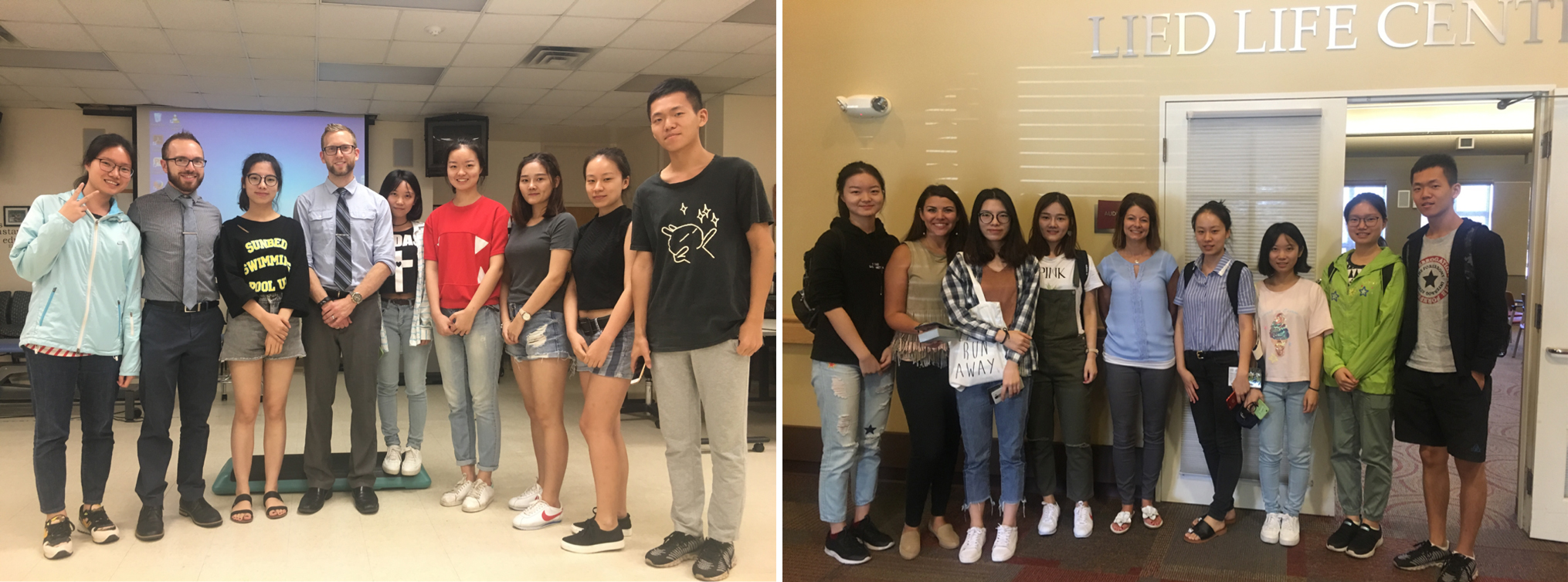
十、毕业要求与学位授予
1.毕业要求:符合学校学籍管理规定的毕业要求,并且获得毕业最低要求174学分,其中必修85.5学分,选修88.5学分。
毕业考核模式:
(1)毕业实习结束前:临床实践操作考核。
(2)毕业实习考评:达到本专业培养目标,完成各实习教学环节,考核合格,修满规定学分。
(3) 毕业论文:毕业前要求完成一篇论文(2018级开始)。
3. 学位授予:符合教育部和我校有关学位授予规定者,经我校学位评定委员会审核通过,授予理学学士学位。
PHYSICAL THERAPY
1. Introduction
The Rehabilitation Therapy Programme was established in 2005 at Guangzhou Medical University, in 2016 the students of programme were trained in the direction of Physical therapy and Occupational Therapy, and in 2020 the Bachelor of Science in Physical Therapy was approved by the Ministry of Education (Code 101009T). Physical therapy is a health care profession requires physical therapist with strong clinical practice ability, logical reasoning thinking and other comprehensive skills to guide and supervise the consultation, examination, evaluation, analysis and diagnosis, prognosis, intervention/treatment and subsequent visit. The aim of physical therapist is to improve the quality of patient’s daily life and help them to return to their family and society by applying modern physical therapy methods, such as Physical Therapy Agents, Manual Therapy and Therapeutic Exercise, and Traditional Chinese Medicine Rehabilitation Techniques (Acupuncture, Massage and Traditional Chinese Exercises).
2. Training Objective
To cultivate high-quality physiotherapists who meet the needs of China's socialist modernization construction and the development of physical therapy programme. Students will be able to develop morality, intelligence, physical education, art and labor comprehensively, have solid basic knowledge, basic theory and skills, and have humanistic emotions, international vision, innovative spirit and practical ability.
The graduates are qualified for the clinics, teaching and scientific research work related to physical therapy.
3. Length of studies and time allocation schedule
Length of studies: 4 years
Time Allocation Schedule (By week)
Semester projects | Academics | Clinical Practice | Exam | Holiday | In total |
1st | 15 | 2 | 1 | 5 | 52 |
2nd | 18 | 2 | 1 | 7 | |
3rd | 18 | 1 | 1 | 5 | 52 |
4th | 18 | 2 | 1 | 7 | |
5th | 18 | 1 | 6 | 52 | |
6th | 13 | 52 | 1 | 13 | |
7th | 52 | ||||
8th | |||||
In total | 100 | 59 | 6 | 43 | 208 |
4. Faculty Member
The programme has 165 teachers, among them 148 are full-time teachers and 17 part-time teachers, 18 of them with WPT approval. 81 teachers with WPT approval in clinical practice sites with rich clinical teaching experience.

Luo Qinglu (Head of the Programme)
Professor, Supervisor for Master and PhD students, Deputy senior therapist. Doctor of Rehabilitation Medicine and Physiotherapy from West China Hospital of Sichuan University (formerly West China Medical University). "Outstanding Teacher of Guangdong Province" in Guangdong Province, "Excellent Teacher" of Guangzhou Medical University, expert of teaching supervision team, instructor of university students' innovation and entrepreneurship, director of Rehabilitation Medicine Teaching and Research Department of the Fifth Affiliated Hospital of Guangzhou Medical University, deputy director of Rehabilitation Medicine; Member of the Physiotherapy Committee [Passed the "Physiotherapist Network Course" examination held by the Chinese Rehabilitation International Education Physiotherapy Expert Committee (Certificate No.: CPTP-240)], the first session of the Physiotherapy Committee of the Chinese Association of Rehabilitation Medicine Standing Committee Member of Physiotherapy University Alliance, member of Orthopedic Rehabilitation Committee of Orthopedic Innovation and Transformation Professional Committee of Chinese Research Hospital Association, standing director of Geriatric Rehabilitation branch of Guangdong Rehabilitation Medicine Association, member of Sports Medicine Branch Committee of Guangdong Medical Association, member of Physical Medicine of Guangdong Medical Association and the Integrative Medicine Group of the 11th Committee of the Rehabilitation Association.
5. Curriculum Setting
(1).Programme components: Basic Sciences, Clinical Medicine, and Physical Therapy.
(2).Professional basic courses: Anatomy, Physiology, Pathology, Pharmacology, Laboratory Diagnostics, Clinical Diagnostics, Medical Imaging, Osteology, Internal Medicine, Neurology, Rehabilitation Psychology, Human Auxology, Medical Statistics, Research Ideas and Methods.
(3).Core curriculum: Introduction to Rehabilitation Medicine, Introduction to Physical Therapy, Functional Anatomy, Manual Therapy, Sports Science, Physical Agents Therapy, Neurological Physical Therapy for Adults, Neurological Physical Therapy for Pediatrics, Physical Therapy of Comprehensive Diseases, Physical Therapy for Orthopedics Diseases and Physical Therapy of Cardiopulmonary Diseases.

6. Practice education
Clinical practice is primary factor of physical therapy. The university attaches great importance to the construction of practical teaching platform and constantly improves the teaching conditions.
The total practice education is multi-level and diversified including three stages, the clinical reasoning and practical skills of students will improve gradually.
Practice education I (2~5 semesters): in courses, students attend labs, clinical departments, rehabilitation centers and so on.
Practice education II (2~5 semesters): including clinical practice, social practice, volunteer activity and overseas academic communication.
Practice education III(6~8 semesters) for Physical Therapy of Musculoskeletal Diseases, Neurological Physical Therapy, Physical Therapy of Cardiopulmonary Diseases, Neurological Physical Therapy of Pediatrics, Home or Community Rehabilitation, Clinical Practice in Rehabilitation Department (Ward and Outpatient), Speech and Swallowing Disorders, Traditional Chinese Rehabilitation, Occupational therapy, and Graduation Appraisal.
7. Practice education site
Under the premise of fully relying on the laboratory of the university, the school now has two specialized center, with a total area of 1200 square meters, and all the experimental teaching centers are open to students.
Rehabilitation Medicine Experimental Education Center: built in 2005, Guangzhou Medical University Rehabilitation Medicine Experimental Education Center is a provincial experimental teaching demonstration center (hereinafter referred to as center), the training room covers an area of more than 900 square meters, the value of existing equipment is more than 18 million RMB, PT training room is about 640 square meter, including Physical Agents Lab, Physical Therapy Lab for Neurological Diseases, Physical Therapy Lab for Cardiopulmonary Diseases, Prosthetics and Orthosis Fabrication Lab, Gait Analysis Room and Motor Recovery Lab, Pediatric Rehabilitation Training Room.

The Clinical Skill Training Center of the Fifth Affiliated Hospital of Guangzhou Medical University was established in March 2018, which covers an area about 300 square meters. It is based on advanced simulation equipment and has a variety of modern simulation teaching instruments and equipment. The center consists of internal medicine skills room, surgical skills room, obstetrics and gynecology, pediatric skills room, simulated ICU skills room, PT, OT, ST skills training room, rehabilitation evaluation room, PBL classroom, standardized patient club. It mainly undertakes the practice education of basic clinical subjects such as Surgery, Pediatrics, Osteology and Internal Medicine in the specialty of physical therapy and occupational therapy.

In practice education III (clinical practice), the programme relies on the affiliated hospitals of the university and the high-quality practice education sites that meet the requirements of international approval of PT and teachers in all parts of country, and build a huge clinical teaching sites system with abundant clinical teaching resources, which provide enough practice opportunities for students and a solid guarantee for the students in physical therapy programme. Currently, there are 11 sites that undertake PT’s practice education, including the Fifth Affiliated Hospital of Guangzhou Medical University, the Second Affiliated Hospital of Guangzhou Medical University, West China Hospital of Sichuan University, Yangzhi Affiliated Rehabilitation Hospital of Tongji University, and the First Affiliated Hospital of Sun Yat-sen University , The Third Affiliated Hospital of Sun Yat-sen University, The Sixth Affiliated Hospital of Sun Yat-sen University, Guangdong Work Injury Rehabilitation Hospital, Zhujiang Hospital of Southern Medical University, the First Affiliated Hospital of Jinan University, Community Healthcare Center of Dasha Street.
8. Innovation and personality development platform
In the course of innovation and personality development offered by the university, students can obtain innovation credits by participating in scientific research, innovation and entrepreneurship, summer courses, competitions and other activities.

9. International Cooperation
Physical therapy programme has employed a number of physical therapy experts and professors from the Hong Kong Polytechnic University and Chung Shan Medical University as the main lecturers of the course. At the same time, starts with the Department of Rehabilitation Sciences of Hong Kong Polytechnic University and the Department of Rehabilitation Therapy of Chung Shan Medical University for teachers training programs and students exchange project, which will send high-quality teachers and students to communicate on a regular basis. In the context of the development of the Greater Bay Area, the programme will make full use of the geographical advantages of Guangzhou and combine the excellent teaching resources of Hong Kong and Macau to expand the teaching platform and strength. Students of the programme have been sent to Creighton University in the United States and Chung Shan Medical University to study and communicate while outstanding teachers have been selected to study MPT at Cardiff University in the United Kingdom, Duquesne University in the United States and the University of South Alabama in the United States.

10. Graduation requirements and degree award
(1) Graduation requirements: Meet the graduation requirements of the University’s Student Status Management Regulations, and obtain the minimum graduation requirement of 174 credits, of which 85.5 credits are compulsory and 88.5 credits are optional.
(2) Graduation assessment model
a. Practice education III evaluation: Achieve the training objectives of this programme, complete each internship section, pass the assessment, and complete the required credits.
b. Final assessment: practical examination.
c, Thesis: One thesis is required before the graduation (From Class 2018)
(3) Degree award
Those who meet the requirements of the Ministry of Education and Degree Awarding of University will be awarded the Bachelor of Science degree after being approved by the Academic Degree Assessment Committee of the university.



